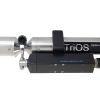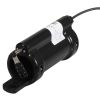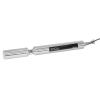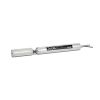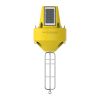TriOS NICO plus UV Nitrate Sensor
Features
- Internal compensation for temperature, turbidity, and organic substances
- RS-485 Modbus RTU output for integration with data collection platforms
- Optional W55 V2 wiper cleans optics & reduces maintenance intervals
- Expedited repair and warranty service
- Lifetime technical support
- More
The new TriOS NICO plus not only offers the parameters NO3-N, NO3, NOx-N and NOx previously known from NICO, but has now been expanded to include numerous additional parameters. These include UVT254, UVT254n, SAK254, CSBeq, BSBeq, TOCeq, DOCeq, turbidity and TSSeq.
An internal temperature correction additionally increases the stability of the measured values. Equipped with the innovative G2 interface with web browser configuration and internal data logger, NICO plus has features that are significantly above the currently available devices on the market, in combination with an attractive price.
The sensor can be easily integrated into existing process control systems and external data loggers using the native RS-485 Modbus RTU output, and the optional W55 V2 wiper reduces maintenance intervals by cleaning the optics before each measurement.
|
Light Source
|
Xenon flash lamp
|
|
|
Detector
|
4 photo diodes + filter
|
|
|
Measurement Principle
|
Attenuation
|
|
|
Optical Path
|
0,3 mm, 1 mm, 2 mm, 5 mm, 10 mm, 20 mm, 50 mm
|
|
|
|
||
|
Parameter
|
NO3-N, NO3, NOx-N, NOx, UVT254, UVT254n, SAC254, CODeq, BODeq, TOCeq, DOCeq, Turb, TSSeq
|
|
|
Measurement Range
|
See measurement ranges
|
|
|
Measurement Accuracy
|
± (5 % + 2-fold detection limit)
|
|
|
Turbidity Compensation
|
Yes
|
|
|
Data Logger
|
~ 2 GB
|
|
|
T100 Response Time
|
20 s
|
|
|
Measurement Interval
|
≥ 10 s
|
|
|
|
||
|
Housing Material
|
Stainless steel (1.4571/1.4404) or titanium (3.7035)
|
|
|
Dimensions (L x Ø)
|
~ 470 mm x 48 mm (10 mm path)
|
~ 18.5“ x 1.9“ (with10 mm path)
|
|
Weight (Stainless Steel)
|
~ 3 kg
|
~ 6.6 lbs
|
|
|
||
|
Digital Interface
|
Ethernet (TCP/IP), RS-485 (Modbus RTU)
|
|
|
Power Consumption
|
≤ 7 W
|
|
|
Power Supply
|
12...24 VDC (± 10 %)
|
|
|
|
||
|
Maintenance Effort
|
≤ 0.5 h/month (typical)
|
|
|
Calibration/Maintenance Interval
|
24 months
|
|
|
System Compatibility
|
Modbus RTU
|
|
|
Warranty
|
1 year (EU: 2 years)
|
USA: 2 years
|
|
|
||
|
Max. Pressure with SubConn
|
30 bar
|
~ 435 psig
|
|
Max. Pressure with Fixed Cable
|
3 bar
|
~ 43.5 psig
|
|
Max. Pressure in FlowCell
|
1 bar, 2...4 L/min
|
~ 14.5 psig at 0.5 to 1.0 gpm
|
|
Protection Type
|
IP68
|
NEMA 6P
|
|
|
||
|
Sample Temperature
|
+2...+40 °C
|
~ +36 °F to +104 °F
|
|
Ambient Temperature
|
+2...+40 °C
|
~ +36 °F to +104 °F
|
|
Storage Temperature
|
-20...+80 °C
|
~ -4 °F to +176 °F
|
|
Inflow Velocity
|
0,1...10 m/s
|
~ 0.33 to 33 fps
|
In The News
Monitoring Meadowbrook Creek: Real-Time Data Collection in an Urban Creek
Meadowbrook Creek in Syracuse, New York, has been monitored by Syracuse University (SU) faculty and students for over a decade. Originally established by Dr. Laura Lautz in 2012, the early years of the program focused on collecting grab water samples for laboratory analysis and evaluating the impact of urban land use, human activities, and natural processes on water resources. Tao Wen , an Assistant Professor in SU’s Department of Earth and Environmental Sciences, took over the program in 2020 and upgraded the existing systems to include 4G modems that allowed for real-time data viewing. [caption id="attachment_39339" align="alignnone" width="940"] An overview of the Fellows Ave monitoring station along Meadowbrook Creek.
Read MoreLancaster County Makes the Switch to Real-Time Water Quality Monitoring Systems
Continuous data collection in Lancaster County, Pennsylvania, started about 5 years ago, and the county will be making a major upgrade over the next year—switching from relying solely on the internal storage of water quality sondes to telemetry units that enable real-time data viewing. [caption id="attachment_39295" align="alignnone" width="940"] The first telemetry unit was installed at LCCD along Little Conestoga Creek. (Credit: Tyler Keefer / LCCD) [/caption] Telling Lancaster County's Story Through Data Since the Lancaster County Conservation District started monitoring county waterways, the goal has remained the same, according to Amanda Goldsmith, Watershed Specialist for the Watershed Department.
Read MoreFrom Florida to the World: How a Smithsonian Research Station is Bridging Gaps in Marine Biology
In the early 2000s, along the coast of northern California, where the redwoods dominate the forests, and the Pacific Ocean shapes shorelines, a Humboldt University undergraduate student took the first steps into a lifelong love of marine biology. Dean Janiak accepted an invitation to help a graduate student with fieldwork in rocky coastal tide pools, and so began a journey that led him from California to Connecticut to Florida and eventually to the world, where he has facilitated research in communities across the globe. While finishing up his masters of Oceanography from the University of Connecticut, Janiak continued researching fouling communities–marine life that live on hard, often artificial surfaces such as docks–at the Smithsonian Environmental Research Center.
Read More




























